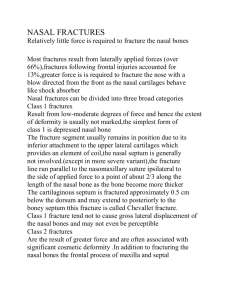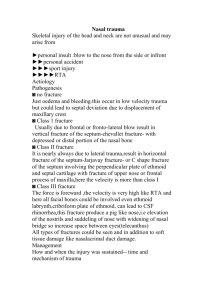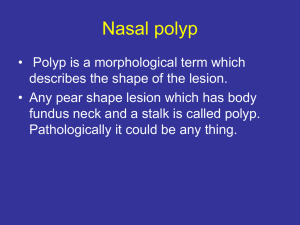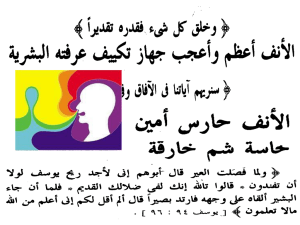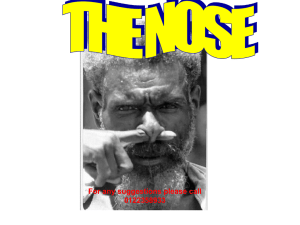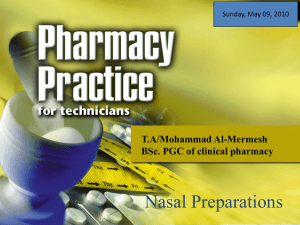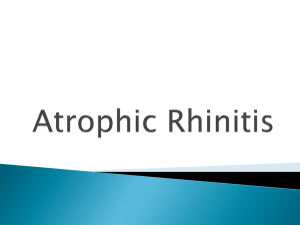Nose Trauma Revised
advertisement
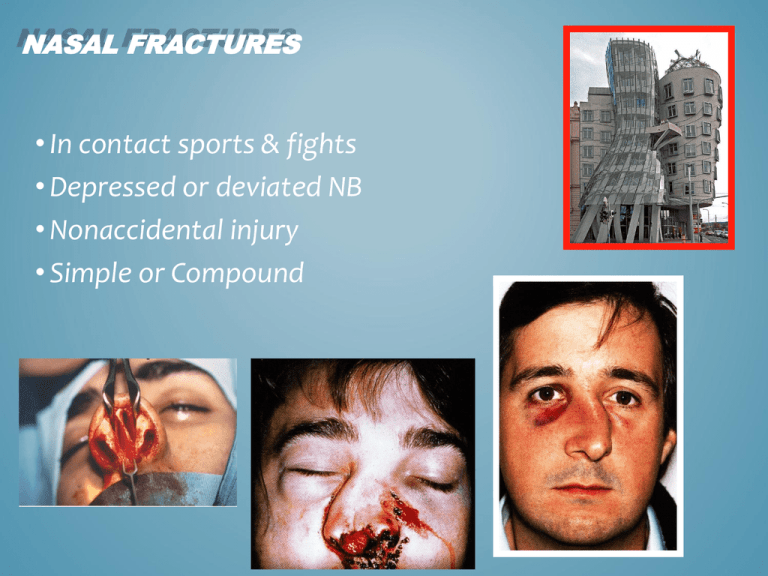
NASAL FRACTURES • In contact sports & fights • Depressed or deviated NB • Nonaccidental injury • Simple or Compound 1 NASAL FRACTURES CLINICAL PRESENTAION • Deformity, Obstruction& bleeding • The deformity is obvious • Careful palpation • Nasal cavity examination • Radiography 2 NASAL FRACTURES TREATMENT • Reduction of NF • Disimpacted bony fragments • Swinging, reduces the fracture • Depressed NB is lifted • External cast 3 FRACTURE OF NASAL BONE 4 Complications of Nasal Trauma –Septal deviation – Septal hematoma – Septal abscess – Causes of cosmetic defects: • poor initial management • secondary infection 5 6 FRACURE NASAL BONE 7 * 8 NASAL FRACTURE 9 COMPLICATIONS OF NF (SEPTAL HEMATOMA) Perichondrium injury Hematoma necrosis abscess int. sepsis [”saddle nose”] 10 (SEPTAL HEMATOMA) Examination: Thin, firm& swollen septum Fluctuant swelling Nasal obstruction Urgent drainage Firm N packing 11 COMPLICATION OF NF DS & NASAL DEFORMITY • DS : “Springiness” • Elective or acutely septoplasty • Difficult 2ndprocedures 12 KEY POINTS IN NF 13 FRACTURES OF THE ZYGOMA &THE BONY ORBIT • Common • Blunt violent injury • Tripod fracture 14 FRACTURES OF THE ZYGOMA &THE BONY ORBIT •Inspection: Globe level •Palpation: Orbital rim •Depressed maxilla •Parasthesia OR Numbness •Jaw& Eye movements 15 FRACTURES OF THE ZYGOMA &THE BONY ORBIT •No Treatment •Reduction: OE,DF,ION damage •Elevation OR Open reduction &wiring 16 Isolated Blowout Fracture – Localized violence --> Orbital contents – A blow (a fist, a tennis ball, a sq. ball, a champagn bottle cork, etc ) – Fractures of the orbital bony floor – Trapping of the orbital contents 17 Blowout Fracture Symptoms – Enophthalmos – Double vision – Limitation of eye movement – Infraorbital nerve sensation disorders 18 Blowout Fracture Diagnosis • Radiographs “tear drop” • Tomograms • Ophthalmologic examination 19 Blowout Fracture Treatment • The antral cavity must be explored: - The bony fragments are exposed - The prolapsed part is replaced - Bridging or stabilization (Lyophilized dura, cartilage or plastic prop) • Alternative or supplementary measures: - Orbital access - Lyophilized dura, silicone sheet, or teflon - Autologous implant to correct enophthalmos 20 21 Ear Foreign Bodies – – – – – – Careful otoscopy Careful history (nature) GA in small children Syringing if TM is intact Using a hook under otoscopic control Complication: TM perforation Injury to ossicles or facial canal 22 23 KEY POINT • Syringing is contraindicated following recent injury or ear surgery and in patients with a history of perforation of the eardrum. 24 FOREIGN BODIES IN THE NOSE • Usually found in children • Beads, coins, peas, pieces of rubber, paper,metal fragments… Symptoms: -unilateral nasal obstruction -unilateral purulent discharge .RHINOLITH [ca] 25 NOSE FOREIGN BODIES 26 RHINOLITH 27 FOREIGN BODIES IN THE NOSE • Diagnosis: -anterior rhinoscopy -radiology -speculum of a fiberoptic auriscope .Treatment: -removal inst.. By probe and tipping - under GA 28 REMOVAL OF NASAL BODY 29 KEY POINT : Unilateral, Offensive, Purulent nasal discharge in a child is usually due to Foreign Body. 30
